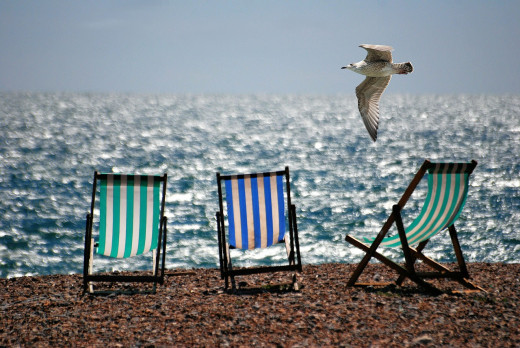Beach Scavenger Hunt Ideas


Going to the beach can be a ton of fun for the entire family. There is plenty of sun, tons of sand to play in and even water to venture into to get away from the hot summer sun. Packing for the beach usually includes some beach towels, chairs to sit in, umbrella that you can stick in the sand to get some much needed shade, picnic type foods and maybe even a book or two. If you have children, you would hopefully be packing them up as well, but what are you bringing along with you to help keep them busy? Children usually have a short attention span and that is why they need more things to stay busy. Pack a few toys, maybe a shovel and bucket, football and even a set of different sized buckets they can use to build sand castles with. You children are going to have a great time playing around in the sand and water, but did you ever think about hosting a beach photo challenge scavenger hunt?
Beach Photo Challenge Scavenger Hunts can be Fun!
Setting up a beach photo challenge scavenger hunt is quite easy, but getting the clues together can be a little bit of a task. There are many things at the beach besides the sand and water, so getting a quick photo in order to complete the scavenger hunt should be quite easy. Children of all ages are walking around with smartphones and that makes photo challenge scavenger hunts even easier. You can set up teams of children and that is why the beach scavenger hunt could be a good idea for a birthday party. With our downloadable clue packs you can get everything you need to set up your beach scavenger hunt for children in PDF format. Plus, the PDF that you download is designed in such a way that you can easily cut the clue out.
The clues are also designed to keep in mind the fact that you are dealing with children, but they are not so easy that the adventure is over before it begins. Going to the beach as a child I always had a lot of fun building sand castles and immediately destroying them as soon as they were complete. Now that I look back, it might have been a fun experience to go through a scavenger hunt at the beach and learn about all of the things that you see down there. Many times you can count on shells, cool looking rocks, different types of birds and other animals and possibly even other treasures depending on the location of the beach. Of course, if you are not bringing children to the beach, there are also photo challenge scavenger hunts that are designed specifically for adults.
Plan Your Beach Scavenger Hunt
Planning the hunt is much easier to do a couple of days ahead of time since you will need time to purchase, download and print the clue packs before you can cut the clues out and setup the adventure. After you have possession of the clue packs, the first thing you should consider is how many children you are going to have participating. This is easy if it will just be your family, but if you are doing this as part of a birthday party, then the numbers can get out of control quickly. Planning ahead of time makes thing easier in the long run and provides you more time for fun once you get to the beach.
When you get to the beach you want everything situated so that there is less time messing around with details and more time having fun. Split the number of children into even groups or teams and start handing out the clues from the clue packs. You might also want to decide if you are going to give a point value for each of the items found or just go with a straight “find as many as you can and hopes its more than the other team” approach. I find that if you add a point value, possibly based on the difficulty it is to find an item, you can return with fewer items photographed, but still gain some points for the team. Make sure you outline rules for the children that are going to be participating in the event. If the beach area is large enough, you want to make sure the children are not getting out of your sight since you are likely to be responsible for their safety.
Some fun twists to add to your beach scavenger hunt
Just like any other game that you play, whether it is with kids or adults, there are a set of rules. By taking advantage of the customization of the scavenger hunt you can apply your own rules to add a few twists to the adventure. For the photo challenge scavenger hunt, you could pass out one clue at a time to each team and see who can find it first. Once a team returns with the item photographed, you hand them the next clue and see how many each team can find in that way. Another way that you can add the element of challenge is to set a timeframe for each clue. This creates the element of panic when an item cannot be found and urges the team members to search out the items as fast as they can.
Because you would be doing the children’s scavenger hunt at the beach, you could also bury the items they need to find so that they are guided in the right direction, but have to dig a little before taking any photos of the items. Just like with all of our other clue packs, they are customizable so adding twists like the one mentioned here is very easy to do. If you are looking for other ideas for your scavenger hunt, you could check out the scavenger hunt idea page for more.
Things to consider when keeping everyone safe
The beach can be a fun location for a beach scavenger hunt, but there are also dangers that you need to keep in mind. You should be mindful of the weather, so that if the sun is not blocked by clouds you have plenty of sunscreen on hand to keep people from burning up. Vitamin D is a good thing, but severe sunburns can put anyone out of commission. If you are planning a scavenger hunt over a larger area, make sure that everyone understands that they will be walking a lot and to dress accordingly with good shoes or at least sandals. Walking around on hot sand all day with bare feet is not going to be a good thing by the end of the day.
Keeping everyone safe also comes down to making sure that nobody gets lost during the adventure. Keep in mind that you might have a few people playing the game that are not familiar with the location so they will need to be watched a little closer than the others. When each team brings back an item or photograph, make sure you do a head count so that you can keep track of all of the players. When dealing with any event like these and when away from home, you should always have a first aid kit for that occasional bee sting, scrape or even a small cut.
Try not to make the hunt to complex
Keep in mind that if you are going to build a scavenger hunt at the beach that you should try and keep it easy to follow for all ages. If you have very young children playing along you should make sure there are items they can understand, as well as keeping the items at a level they can see them. Younger children are typically shorter, so keep that in mind if you are hiding the objects yourself. The items should be clear and concise as well, so there is no change for confusion during the scavenger hunt.
I think that if you keep all of these things in mind before the beach scavenger hunt, the event should go off with a bang. If you are interested in other clue packs that we sell, you should check out the website today. There are some packs that are available at a discount if you buy them all a
Some Alternative Beach Scavenger Hunt Ideas:
Search for natural things:
This is probably the most fun part of being on a beach scavenger hunt. Here, you are able to use the natural resources that are all around you. Take advantage of this by having the game players search for pieces of seaweed, a piece of sea sponge, bits of moss, rocks of different colors, a sample of coral, or different kinds of seashells. This is a great way to discover the fantastic natural assets that your environment has to offer. This idea could apply for adult scavenger hunts as well as a family or child scavenger hunt. To make the game more challenging, put things on the list that include something with a specific color, feel, or other kind of characteristic. For example, you could specify that players find a rock that has a pink color to it, something that has a soft texture, or a shell that has spots on it. The more specific the clues that are given are, the more challenging and fun the game will be, so go for it!
Beach Cleanup:
Are you passionate about keeping the environment clean and healthy? Are you or your club or group looking for a great way to volunteer while aiding the environment? Turn a cleanup event into a scavenger hunt for adults! Have the members of your group pick up as much trash as they can while checking certain items off of the list, such as plastic bottles, metal cans, pieces of paper, or plastic bags. This game can be played in groups or with individual players. You can even make it into a contest to see how many pounds of trash each person or group can collect from the beach. This activity is an excellent way to get involved with volunteering and to do your part to keep the little corner of the Earth you inhabit clean and beautiful.
- Seaside scavenger hunt clues and ideas
Get some free clues and ideas for a great day scavenger hunting on the beach.

Build a collection:
This is probably the most fun way for those passionate about collecting natural items such as seashells or interesting and colorful rocks to build their collection in a fun and challenging way. Search for anything and everything under the sun—literally. Make clues specific so that the hunt is more challenging and interesting. This also helps to make the items collected more interesting and unique, adding fantastic and fascinating pieces to your collection of seashells, rocks, pieces of coral, or other samples of beach life. You can even have players of this game photograph the items they find and turn the scavenger hunt into a photo scavenger hunt.
Creative hiding places:
This is not only the most fun part of a scavenger hunt, but it is the most essential thing to do if you have the good fortune to be holding your child, family, or adult scavenger hunt in an area filled with sand, sea, and all the fun parts of being on the beach. Bury the items that you want players to look for in the sand, but be careful: burying items too deep will ruin the fun of the scavenger hunt if it keeps your players from finding anything or being able to check any items off of their list. You can also hide items underneath or behind rocks, if they are available. Get even more creative by hiding whatever is being searched for in some kind of seashell or even a glass bottle and place it on the shoreline. This makes the scavenger hunt even more challenging and a whole lot more fun for adults and older kids. Getting creative with hiding places is definitely a great thing to remember to do on any scavenger hunt.
Play With the Sand:
Sand has to be one of the most abundant resources in a beach environment, second only to water, of course. What better material to use on a fun-filled scavenger hunt? Instead of having players of your game search for and collect items off of a list, have them perform entertaining feats and challenges using sand, instead. This could be as simple as having them dig a big hole in the sand with some sand toys or as complex as building a big sand castle. You can even challenge players in your game to take a photo of themselves or someone else with their bodies buried in the sand as part of a photo scavenger hunt. You could also challenge them to make sculptures of certain figures out of sand. For example, ask players to make a sculpture of a dolphin made completely out of sand and snap a photo with it. This sounds complex, but it’s important to make the challenges as unique as you can in order to make the game as fun as possible for adults and older kids. For younger children, keep the sand challenges short, simple, and, above all, safe for them to do. This is a really creative way to conduct a scavenger hunt and it ends up being a lot more fun than just searching around for some items.
Swimming:
Are there some strong swimmers in your family or group? Tell them to bring their bathing suits to your next beach scavenger hunt. Make sure to take advantage of the most fun and awesome part of going to the beach: the swimming! Challenge adults and older kids to swim to a certain point on the beach to another. You could even turn it into a race between two or more players or between two groups of people. The safest way to do this is to have the players swim only parallel to the shoreline, not out into the ocean away from the beach. This will keep them from venturing too far out and getting caught up in a strong current and possibly getting lost or injured. This is because most waves are a few hundred yards in width, so swimming parallel to the shoreline will help you to avoid getting caught up and get you out of a sticky situation. You should always be as safe as possible if swimming is part of your game, so have people use flotation devices if you deem it necessary and only ask people who know how to swim to perform these tasks.
Treasure Hunt:
We all dreamed of a good, old-fashioned, pirate style treasure hunt when we were kids. Go with a classic swash-buckling theme for this hunt and have your players follow a series of clues in order to find the treasure. The treasure could consist of anything you like: party favors, candy, a trophy, or anything else that the players of your game would love to get their hands on. The more they want the treasure, the more fun and exciting the game becomes. Go all the way with the pirate theme by placing your treasure in a treasure chest. You can probably find one of these made of plastic or some other material that is easy to deal with at a toy store or costume shop. Provide clues along the way to the spot where the treasure is buried (marked by an “X”, of course) by having players us a compass to find their way around the beach and guide them to certain landmarks. These landmarks can be anything from a big boulder to a hot dog stand. This is a great activity to do with a small group of adults or older kids who work in teams.
Some Scavenger Hunt Tips:
Be safe:
This is an obvious must for any activity. Make sure everyone can swim if in they are going to be in the water and have them swim parallel to the shore and not go too far away. It’s also essential to ensure that children are supervised at all times, even older kids. Lifeguards are a must for beach activities, so make sure that there is one around. Always act in accordance with the rules posted by local authorities and get permission for any kind of larger activity on the beach if it is necessary.
Don’t Lose It:
Don’t get things lost in the tide by hiding it too close to the water. This is easy to do and probably one of the biggest problems with beach-side activities like these. Also try to make sure that everyone involved is familiar with the area and that the game is not held in some remote location. If one of the players gets lost, there should at least be people around from whom they can get help.
Have fun!:
Of course, this is the most important part of any game. Always have fun with whomever you happen to be playing with. Whether you are having some quality time with family or partying with a bunch of friends, always make sure you have a ball!

© 2014 Brett









